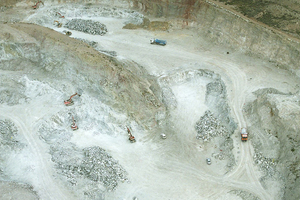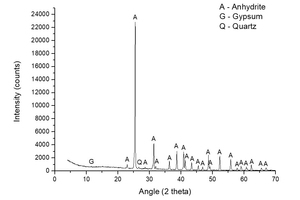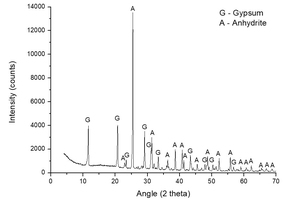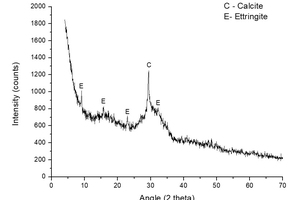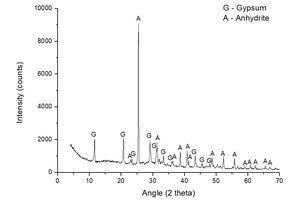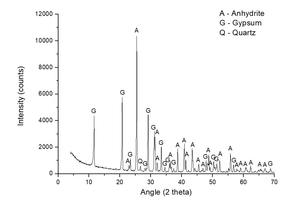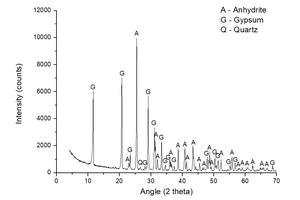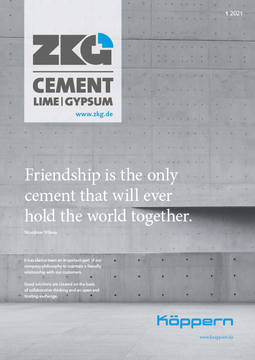REFERENCES
[1] Rodríguez-Orejón, A.; del Río-Merino, M.; Fernández-Martínez, F.: Characterization mixtures of thick gypsum with addition of treated waste from laminated plasterboards. Mater. Construcc. 64 [314], e018 (2014)
[2] Jiménez-Rivero, A.; García-Navarro, J.: Characterization of quality recycled gypsum and plasterboard with maximized recycled content. Mater. Construcc. 67 (328), e137 (2017)
[3] Nguyen, H.A.; Chang, T.P.; Chen, C.T.; Yang, T.R.; Nguyen, T.D.: Physical-Chemical Characteristics of an Eco-Friendly Binder Using Ternary Mixture of Industrial Wastes. Mater. Construcc. 65 [319], e064 (2015)
[4] Singh, M.; Garg, M.: Study on anhydrite plaster from waste phosphogypsum for use in polymerised flooring composition. Constr. Build. Mater. 19:1, 25-29 (2005)
[5] López, F.A.; Tayibi, H.; García-Díaz, I.; Alguacil, F.J.: Thermal dehydration kinetics of phosphogypsum. Mater. Construcc. 65 [319], e061 (2015)
[6] Jarosinski, A.: Properties of anhydrite cement obtained from apatite phosphogypsum.
Cem. Concr. Res. 24:1, 99-108 (1994)
Cem. Concr. Res. 24:1, 99-108 (1994)
[7] Leškevičienė, V.; Nizevičienė, D.: Influence of the setting activators on the physical mechanical properties of phosphoanhydrite. Chem. Ind. Chem. Eng. Q. 20:2, 233-240 (2014)
[8] Rais, F.; Jelidi, A.; Kamoun, A.; Chaabouni, M.; Sergent, M.; Phan-Tan-Luu, R.: Use of an ellipsoidal subregion of interest in the space of mixture components to the optimization of a fluoroanhydrite-based self-leveling floor composition. Chemom. Intell. Lab. Syst. 74:2, 253-261 (2004)
[9] Gallardo, M.; Almanza, J.M.; Cortés, D.A.; Escobedo, J.C.; Escalante, J.I.: Synthesis and mechanical properties of a calcium sulphoaluminate cement made of industrial wastes. Mater. Construcc. 64 [315], e023 (2014)
[10] Bazalda-Medellín, M.E.; Fuentes, A.F.; Gorokhovsky, A.; Escalante-García, J.I.: Early and late hydration of supersulphated cements of blast furnace slag with fluorgypsum. Mater. Construcc. 65 [317], e043 (2015)
[11] Córdoba, P.: Status of Flue Gas Desulphurisation (FGD) systems from coal-fired power plants: Overview of the physic-chemical control processes of wet limestone FGDs. Fuel 144, 274-286 (2015)
[12] IGME. Instituto Geológico y Minero de España: Mapa geológico de España. Hoja Elda. 871, pp. 28-34. Servicio de publicaciones MInisterio de Industria y Energía, Madrid (1978)
[13] Vian, A.: Curso de Introduccion a la Quimica Industrial, Editorial Alhambra, S.A., Madrid (1976)
[14] Klimchouk, A.: The dissolution and conversion of gypsum and anhydrite. Int.]. Speleol. 25, pp. 3-4 (1996)
[15] Sievert, T.; Wolter, A.; Singh, N.B.: Hydration of anhydrite of gypsum (CaSO4.II) in a ball mill. Cem. Concr. Res. 35:4 623-630 (2005)
[16] Singh, N.B.: The activation effect of K2SO4 on the hydration of gypsum anhydrite, CaSO4(II). J. Am. Ceram. Soc. 88:1, 196-201 (2005)
[17] Žvironaitė, J.; Makuteniene, D.; Keriene, J.; Kizinievič, V.: The peculiarities of hardening of composite anhydrite cement pozzolana binding material with not burned natural anhydrite. Mater. Sci. (Medžiagotyra) 16, 2, pp. 159-164 (2010)
[18] Wtorov, B.; Fischer, H.B.; Stark J.: To stimulate naturanhydrite. Internationale Baustofftagung (14. ibausil), Weimar (2000)
[19] Žvironaitė, J.; Kizinievič, V.: Researches into possibility of application of lithuanian anhydrite. Proceedings 10th International Conference Modern Building Materials, Structures and Techniches, Edited by P. Vainiūnas and E. K. Zavadskas. Vilnius: Technika. pp. 346-350 (2010)
[20] Tcheichvili, L.: Sobre la transformación de anhidrita II en Bihidrato. Parte I. Bol.Soc.Esp.Cerám., 7, 1,
pp. 55-94 (1968)
pp. 55-94 (1968)
[21] Israel, V.D.: Investigations into the relationship between the degree of hydration, flexural tensile strength and microstructure of setting anhydrite. ZKG International 49, 4, pp. 228-234 (1996)
[22] Singh, M., Garg, M.: Activation of gypsum anhydrite slag mixtures. Cem. Concr. Res. 25:2, 332-338 (1995)
[23] Leskeviciene, V.; Sarlauskaite, I.; Nizeviciene, D.; Kybartiene, N.: Influence of the gypsum dehydration temperature and alkali additives on the properties of anhydrite cement. Sci. Sinter. 42:2, 233-243 (2010)
[24] Leškevičienė, V.; Nizevičienė, D.: Anhydrite binder calcined from phosphogypsum, Ceram.-Silik. 54, 2,
pp. 152-159 (2010)
pp. 152-159 (2010)
[25] Müller, M.; Lang, G.: New PCEs targeted selection of superplasticizers for various binder systems.
ZKG International 69, Drymix Special, pp. 30-33 (2016)
ZKG International 69, Drymix Special, pp. 30-33 (2016)
[26] UNE-EN 196-6: 2010. Methods of Testing Cement-Part 6. Determination of Fineness. AENOR (2010)
[27] UNE-EN 13454-2+A1: 2009. Binders, composite binders and factory made mixtures for floor screeds based on calcium sulfate. Part 2: Test methods. AENOR (2009)
[28] UNE 102042: 2014. Gypsum plasters. Other test methods. AENOR (2014)
[29] El-Didamony, H.; Aly, A.H.; Sharara, A.M.; Amin, A.M.: Assessment of cement dust with anhydrite as an activator for granulated slag. Silic.Indus. 62, 1-2, pp. 31-36 (1997)
[30] UNE-EN 13454-1: 2006. Bimders, composite binders and factory made mixtures for floor screeds based
on calcium sulfate. Part 1: Definitions and requirements. AENOR (2006)
on calcium sulfate. Part 1: Definitions and requirements. AENOR (2006)
[31] Cotton, A.; Wilkinson, G.: Quimica Inorgánica avanzada. 884-885. Limusa, Mexico (1976)
[32] Lewry, A.J.; Williamson, J.: The setting of gypsum plaster. Part III. The effect of additives sand
and impurities. J. Mater. Sci. 29, 6085–6090 (1994)
and impurities. J. Mater. Sci. 29, 6085–6090 (1994)
[33] Plank, J; Vlad, D.: Studies on the effect of polycarboxylate superplasticizers in sulphatically activated
anhydrite self-levelling floor screed. ZKG International 59, 4, pp. 28-38 (2006)
anhydrite self-levelling floor screed. ZKG International 59, 4, pp. 28-38 (2006)

